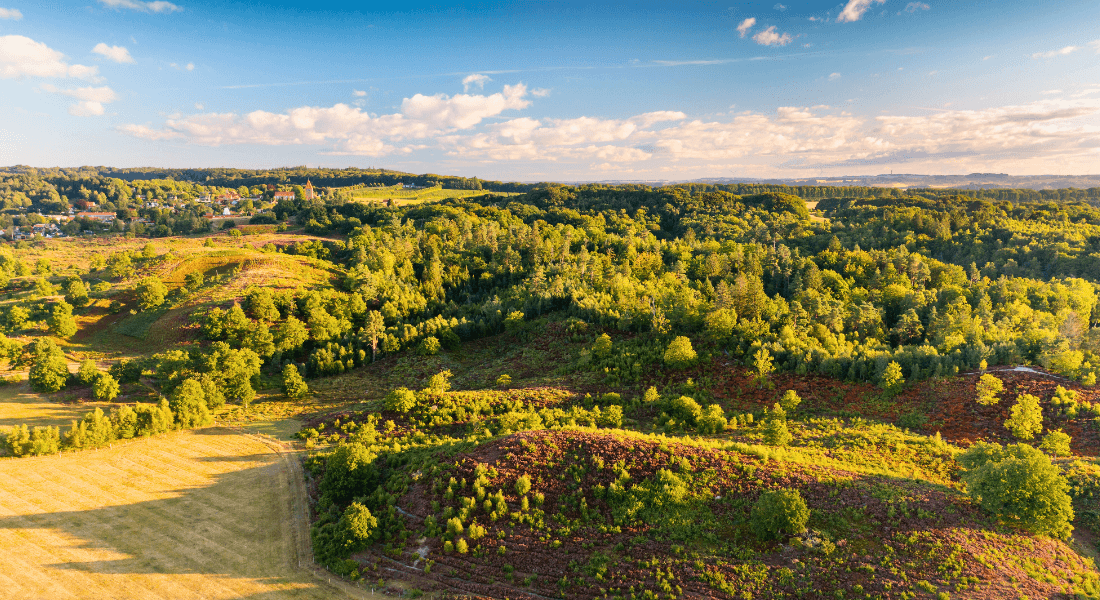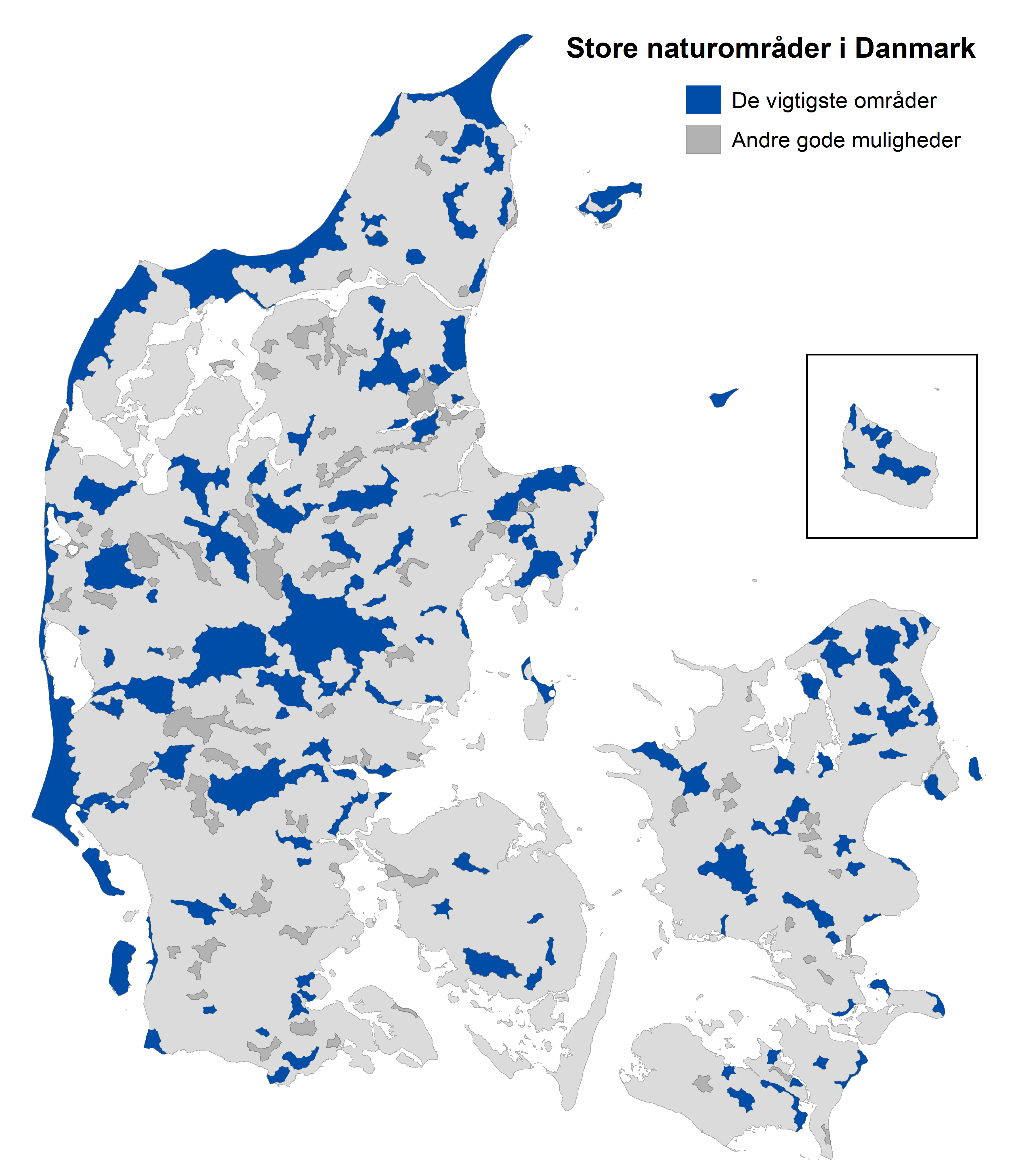New report published on Danish nature
A new report shows concrete ways to ensure Denmark's biodiversity by creating large, interconnected natural areas. The report highlights, among other things, where the best opportunities are, where we can benefit biodiversity the most, and what the efforts will cost.

It is a political decision that Denmark should contribute to the EU and UN agreements on 30% protected nature. However, today Denmark has at most 7% effectively protected nature, and 17% of our species are threatened and at risk of disappearing. To reverse the loss of biodiversity, more space for nature and larger, interconnected natural areas are needed.
But where, how, and how much? What does it cost, and how do we prioritize? Answers to these questions are all illuminated in the new report Mere, bedre og større natur i Danmark ("More, better, and greater nature in Denmark"), which is the largest analysis of its kind to date based on the most comprehensive dataset.
- In the report, we document that there are good opportunities in large parts of Denmark to establish large natural areas, and that such a strategy could cover a very large part of Danish biodiversity, explains Carsten Rahbek, Professor and initiator of the project.
The report is illustrated with maps showing where the larger natural areas are today and how they can be expanded by converting cultivated forests and farmland into nature. Specifically, the report's authors point to 239 possible natural areas larger than 500 hectares, including 41 places where more than 5,000 hectares of contiguous nature can be achieved.
Many of the large areas, with proper management, could develop into wild, varied, and dynamic nature that spans forested and open habitats with lakes, river valleys, marshes, and coastal areas. Focusing on these areas would thus not only benefit biodiversity but also create wilder, more varied, and beautiful nature across the country, attractive for both residents and tourists to visit, live in, or live near.
Here are the 149 most important areas
Through transparent data-based analyses, the relative importance of the areas for biodiversity is highlighted. Different scenarios show, among other things, how to appropriately prioritize among the 239 areas, e.g., over time or according to political ambition levels.
In the report's main scenario, 149 large areas are identified as the most important of the 239 possible. Together, they constitute an optimal and cost-effective network of areas in Denmark, where the maximum number of species is covered by the effort (Figure A). These areas alone will contribute nature on an area equivalent to 16% of Denmark's area. However, to implement the effort, 8% of Denmark's agricultural land and 43% of cultivated forests need to be converted to "new nature."
A network of large areas, however, cannot stand alone. A broad effort outside the large areas is also necessary, not least for the sake of rare and threatened species.
- It is a major task to ensure Denmark's biodiversity and contribute substantially to the international area targets, but our report shows concrete ways to get there, says Anders Højgård Petersen, Special Consultant and lead author of the report.

What does it cost?
The report's socioeconomic analyses provide solid estimates of the costs in terms of lost agricultural and forest production from areas converted to nature. They also shed light on future costs, depending on how we choose to manage the nature, for example, with or without fences and large animals.
- We estimate, for example, that it will cost between 1.5 and 3 billions annually to establish and manage a nationwide and spatially cost-effective network with 149 large natural areas in Denmark, says Anders Højgård Petersen.
The core of this is that an optimal and cost-effective effort to ensure space for biodiversity in Denmark requires prioritization, and this prioritization should be done on an informed basis, concludes Carsten Rahbek:
It is our hope that the report will provide a knowledge-based foundation for the societal and political discussion on how we both ensure Danish biodiversity and contribute to international political agreements. At the same time, the report is a timely starting point for discussing how we use the country's land in general, which is a very essential discussion currently taking place in all parts of Danish society.
An important tool for decision-makers
The maps and results can also be used more concretely to prioritize the funds to be invested in quality improvements of existing nature as well as nature restoration and the creation of new nature—both by the state, municipalities, businesses, and foundations, and among private landowners.
The report is the result of the project "More, better, and greater nature in Denmark" conducted from 2021-2024 at the Center for Macroecology, Evolution, and Climate (CMEC) at the University of Copenhagen with support from the 15 Juni Fonden and the Aage V. Jensen Naturfond. The project was carried out under the leadership of Professor Carsten Rahbek and Special Consultant Anders Højgård Petersen in collaboration with researchers from the Department of Food and Resource Economics (IFRO), University of Copenhagen.
About the report
Petersen, A. H., B. Hasler, T. Laage-Thomsen, M. Termansen og C. Rahbek (2024): Mere, bedre og større natur i Danmark. Hvor, hvordan og hvor meget? Center for Makroøkologi, Evolution og Klima, Globe Institute, Københavns Universitet.
ISBN 978-87-972724-1-1
Download the report (in Danish)
Contact
Carsten Rahbek
Professor
Anders Højgård Andersen
Special Consultant
